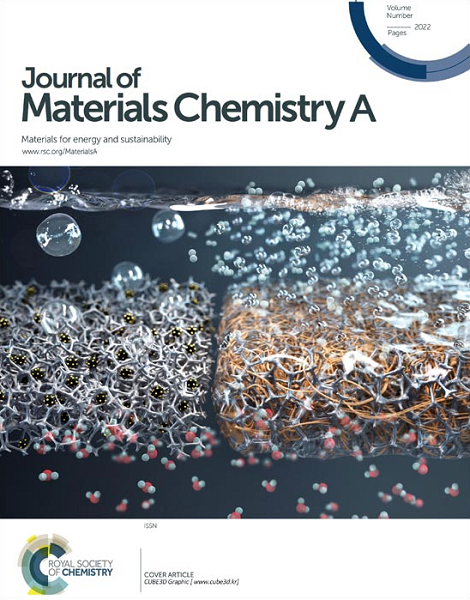打破中毒范式:以声子诱导不确定性为重点的高熵合金的高通量DFT筛选
IF 10.7
2区 材料科学
Q1 CHEMISTRY, PHYSICAL
引用次数: 0
摘要
虽然表面中毒通常被认为会使电催化失活,但本研究通过系统的高通量机器学习和密度泛函理论(DFT)对高熵合金(HEAs)的探索,说明了它在促进析氢反应(HER)方面的有意应用。在M1M2M3M4M5-HEA平台上系统探索了11种过渡金属(Fe, Co, Ni, Cu, Ru, Rh, Pd, Ag, Ir, Pt和Au),以建立它们的热力学稳定性,动力学行为和Co *中毒能力。CO*中毒表面令人惊讶地将平均HER过电位从0.82 V降低到0.33 V。其中CO*中毒的FeCoCuPdAu-HEA催化剂的HER过电位为0.06 V,低于清洁表面的0.18 V。我们的态密度分析表明,CO和活性位点之间的轨道杂化改变了H*中间体的稳定性。我们的分析表明,中间体的价电子数、金属的d轨道数和原子半径是吉布斯自由能预测的关键描述符。从头算分子动力学(AIMD)计算包括过电位的不确定性(标准偏差≈0.16 V)和由声子诱导的能量波动引起的低于10飞秒的量子相干损失。本研究对高熵电催化剂的中毒表面进行了基础性的研究,并引入了新的概念来考虑声子引起的能量波动。本文章由计算机程序翻译,如有差异,请以英文原文为准。

Breaking the poisoning paradigm: a high-throughput DFT screening of high-entropy alloys with a focus on phonon-induced uncertainty
Although surface poisoning is usually thought to deactivate electrocatalysis, this work illustrates its intentional application in promoting the hydrogen evolution reaction (HER) via a systematic high-throughput machine learning and density functional theory (DFT) exploration of high-entropy alloys (HEAs). Eleven transition metals (Fe, Co, Ni, Cu, Ru, Rh, Pd, Ag, Ir, Pt, and Au) were systematically explored in the M1M2M3M4M5-HEA platforms to establish their thermodynamic stability, dynamic behaviors, and CO*-poisoning capability. CO*-poisoned surfaces surprisingly reduced the average HER overpotential to 0.33 V from 0.82 V for a clean surface. In particular, CO*-poisoned FeCoCuPdAu-HEA catalysts have an HER overpotential of 0.06 V, which is lower than that of the clean surface, which exhibits an HER overpotential of 0.18 V. Our density of states analysis indicates that orbital hybridization between CO and active sites modifies the stabilization of the H* intermediate. Our analysis indicates that the number of valence electrons of the intermediates and the d-orbital numbers and atomic radius of the metals are critical descriptors for Gibbs free energy predictions. Ab initio molecular dynamics (AIMD) calculations includes uncertainties (standard deviation ≈ 0.16 V) in overpotentials and a quantum coherence loss of below 10 femtoseconds due to phonon-induced energy fluctuations. The study presents a fundamental investigation on the poisoned surface of high-entropy electrocatalysts and introduces new concepts to consider the phonon-induced fluctuation in energy.
求助全文
通过发布文献求助,成功后即可免费获取论文全文。
去求助
来源期刊

Journal of Materials Chemistry A
CHEMISTRY, PHYSICAL-ENERGY & FUELS
CiteScore
19.50
自引率
5.00%
发文量
1892
审稿时长
1.5 months
期刊介绍:
The Journal of Materials Chemistry A, B & C covers a wide range of high-quality studies in the field of materials chemistry, with each section focusing on specific applications of the materials studied. Journal of Materials Chemistry A emphasizes applications in energy and sustainability, including topics such as artificial photosynthesis, batteries, and fuel cells. Journal of Materials Chemistry B focuses on applications in biology and medicine, while Journal of Materials Chemistry C covers applications in optical, magnetic, and electronic devices. Example topic areas within the scope of Journal of Materials Chemistry A include catalysis, green/sustainable materials, sensors, and water treatment, among others.
 求助内容:
求助内容: 应助结果提醒方式:
应助结果提醒方式:


